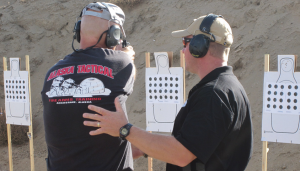by Chris Cerino
What are your expectations when you sign up for a training course? Hopefully you expect to learn something new or validate the skills or knowledge you already have. I’m relatively sure that you would expect to do some form of physical activity, especially if the training is a firearms shooting course. One can learn a lot from listening to someone talk on a subject; however, that spoken word combined with a hands-on experience creates a more productive learning atmosphere.
I’m not exactly sure what some of the students who have come to my training classes expected. This past summer we trained a couple hundred individual shooters in everything from concealed carry operations to tactical rifle. The age, gender and physical composition of these students covered the entire gamut of possibilities. We can work through these three factors. You just need to have the right equipment. Ahhhhh, equipment! Equipment can make or break your training event.
You have to wonder what a person’s thinking when he shows up to a firearms training course with flip flops on his feet. Not even sandals! Flip flops! Flip flops seem bad but we were able to work through them because the rest of the gear was correct. Shorts are one thing, but what do you do at a pistol course with Yoga pants? No belt, no holster and certainly no belt loops on those Yoga pants. It’s hard to train with those basics. These are two of the most bizarre instances, but there are many other examples of trainees being unprepared. People regularly show up without holsters, belts or protective gear. Many show up with guns not well suited for training, at least not if training consists of firing 500 to one thousand rounds in a day or two.
Training is serious business. What you do while training is what you will do when you have no time to think. With the majority of 2013 past, we have now had time to reflect on the poor planning and choices of some of our students. We want to help others make better decisions in order to have the best training experiences possible in 2014.
Your clothing should be form-fitting and comfortable. Wear pants that fit well and don’t droop or sag in the crotch. You will be bending over to pick up magazines and dropped items constantly on the range. Wear shirts that are long enough to tuck in so you’re not fumbling your draws by grabbing a handful of shirt when you reach for your pistol. Clothing should allow movement for positional shooting, like shooting from the prone or even from under a barrier. Especially if it’s a rifle class! Be prepared for hot weather, cold weather or, in Ohio, both. Quality layers conducive to the aforementioned, which can be donned or doffed depending on the time of day! Bring rain gear if you’re going to be outside. There is a fine line between being tough and being stupid. Be comfortable so you can enjoy training.
When it comes to belts and holsters, synthetic is your best bet in a training environment.
I know there is a certain look and feel to leather for both but save leather for carry or dress-up days. A leather pancake holster and belt can be comfortable and form-fitting for daily carry. However, harsh, high repetition training environments can really beat them up and decrease their service life.
I understand that you carry your gun inside the pants normally but you can’t be constantly drawing and holstering from an IWB holster during training.
Remember you are going to be learning new things so your mind won’t be focusing on the single aspect of holster.

Chris Cerino is a nationally known firearms instructor and competitor who’s been training law enforcement officers and military for more than 12 years. Chris has worked in peacekeeping positions for municipal, county, state and federal agencies spanning more than 20 years. A majority of those years have been spent in tactical and firearms related fields. Literally immersed in pistol training for years his skills are founded in life experience. Chris is the director of training for Chris Cerino Training Group LLC, teaching in a “do as I do” fashion. Chris is a current peace officer and remains immersed in the firearms industry by teaching, competing and working across the nation. You can email him at: chris@cerinotraininggroup.com, or phone: 330-608-6415.



